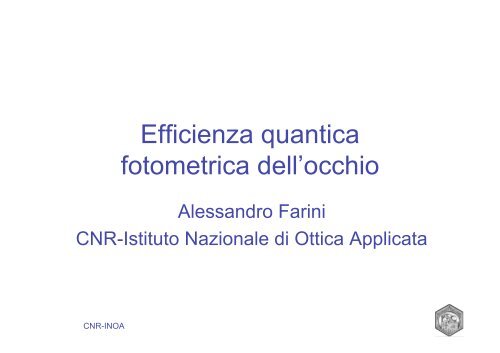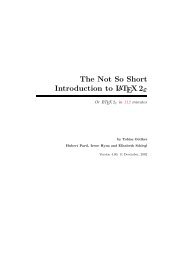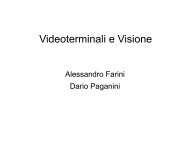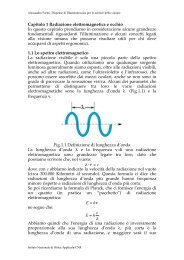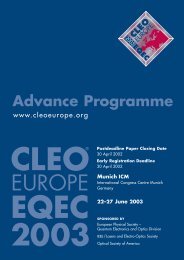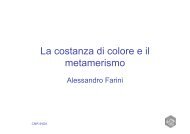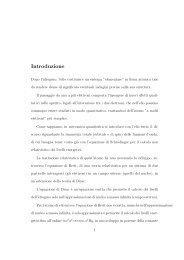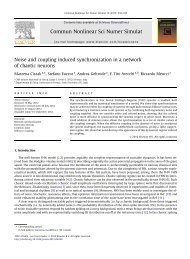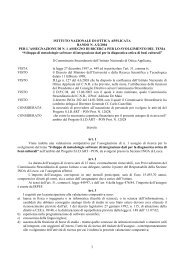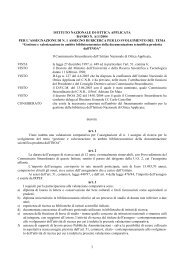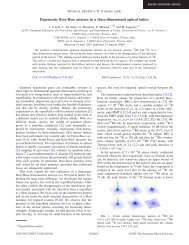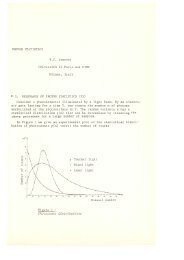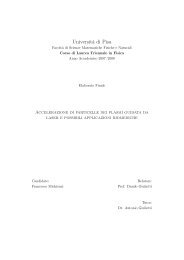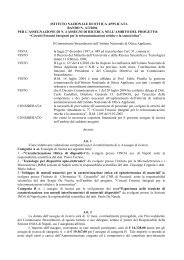Efficienza quantica - Istituto Nazionale di Ottica Applicata
Efficienza quantica - Istituto Nazionale di Ottica Applicata
Efficienza quantica - Istituto Nazionale di Ottica Applicata
Create successful ePaper yourself
Turn your PDF publications into a flip-book with our unique Google optimized e-Paper software.
<strong>Efficienza</strong> <strong>quantica</strong><br />
fotometrica dell’occhio<br />
Alessandro Farini<br />
CNR-<strong>Istituto</strong> <strong>Nazionale</strong> <strong>di</strong> <strong>Ottica</strong> <strong>Applicata</strong><br />
CNR-INOA
<strong>Efficienza</strong> <strong>quantica</strong><br />
fotometrica<br />
• L’efficienza <strong>quantica</strong> fotometrica è il<br />
rapporto tra i fotoni incidenti sulla<br />
cornea e quelli che producono un<br />
segnale neuronale<br />
CNR-INOA
Per<strong>di</strong>ta <strong>di</strong> efficienza<br />
Tra le cause <strong>di</strong> per<strong>di</strong>ta <strong>di</strong> efficienza possiamo<br />
considerare:<br />
• La parte <strong>di</strong> fotoni che viene assorbita prima <strong>di</strong><br />
arrivare sulla retina<br />
• La frazione <strong>di</strong> fotoni che arrivano sulla retina ma<br />
non sono catturati dai fotorecettori<br />
• La frazione <strong>di</strong> fotoni che non sono assorbiti dai<br />
fotopigmenti o non isomerizzano le molecole dei<br />
fotopigmenti<br />
CNR-INOA
Riflessione sulla cornea<br />
• La percentuale <strong>di</strong> fotoni riflessi può<br />
essere ricavata dalla formula <strong>di</strong> Fresnel:<br />
(<br />
R = n 2<br />
" n ) 2<br />
1<br />
( n 2<br />
+ n ) 2<br />
1<br />
n cornea =1.376<br />
!<br />
CNR-INOA
Trasmittanza dell’occhio<br />
Metti qui immagine figura 4 da pagina<br />
24.10 <strong>di</strong> charman<br />
CNR-INOA
Trasmittanza della cornea<br />
Packer fig.2.4 a<br />
La cornea nel visibile è quasi trasparente (assorbe<br />
meno del 10% a 800 nm e meno del 20% a 400 nm).<br />
Sotto i 300 nm assorbe il 99%<br />
CNR-INOA
La pupilla<br />
• Tra cornea e cristallino si trova la<br />
pupilla, che non ha particolari<br />
caratteristiche <strong>di</strong> trasmittanza (essendo<br />
un foro)<br />
CNR-INOA
Il cristallino e altri mezzi<br />
CNR-INOA<br />
Boettner and Wolter, 1962
Trasmittanza del cristallino<br />
CNR-INOA figure from Wyszecki and Stiles, 1982
Trasmittanza e Densità <strong>Ottica</strong><br />
• Conoscendo la trasmittanza <strong>di</strong> una<br />
lente per un certo spessore, è possibile<br />
ottenere la trasmittanza per ogni<br />
spessore<br />
• A tale scopo conviene utilizzare il<br />
concetto <strong>di</strong> Densità <strong>Ottica</strong> D che varia<br />
proporzionalmente allo spessore<br />
D=log(1/T)<br />
CNR-INOA
Un esempio<br />
T%=25 %<br />
T= 0.25<br />
Spessore d= 2mm<br />
D=log(1/T)=0.60<br />
Nuovo spessore d’=3mm<br />
D’=(d’/d) . D=0.9<br />
T’=1/10 D’ =0,125<br />
T’%=12,5%<br />
CNR-INOA
Ingiallimento del cristallino<br />
• The absorbance of blue light in the crystalline lens is<br />
commonly referred to as ‘‘yellowing’’ of the human<br />
lens. This yellowing of the lens increases dramatically<br />
as it ages. The lens optical density toward the blue<br />
wavelengths increases by about 0.1 to 0.15 log units<br />
per decade, provided that we assume that<br />
components other than the lens change little as they<br />
age. Accelerations in this rate have been found for<br />
eyes over age 60 (106,107), and it is proposed that<br />
this increase is due to the prevalence of cataract in<br />
that age group.<br />
A.Roorda Human visual system - image formation<br />
CNR-INOA
CNR-INOA
Sviluppo del cristallino<br />
Nei primi mesi <strong>di</strong><br />
vita il cristallino<br />
mostra una<br />
piccola<br />
trasmittanza<br />
nell’UV<br />
CNR-INOA
Il pigmento maculare<br />
relative absorbance<br />
0.6<br />
0.5<br />
0.4<br />
0.3<br />
0.2<br />
0.1<br />
macular pigment<br />
P435<br />
P410<br />
Picco <strong>di</strong><br />
assorbimento<br />
a 458 nm<br />
0<br />
400 450 500 550 600<br />
wavelength (nm)<br />
maximum absorptance<br />
0.3<br />
0.2<br />
0.1<br />
macular pigment<br />
P435<br />
P410<br />
CNR-INOA<br />
0<br />
-1000 -500 0 500 1000<br />
retinal eccentricity (microns)<br />
from Snodderly, IOVS, 1984
Scopo del pigmento maculare<br />
Il pigmento maculare ha uno scopo<br />
• Protettivo (in particolare dalla<br />
degenerazione maculare)<br />
• Miglioramento <strong>di</strong> contrasto (stile “lenti<br />
gialle”)<br />
• Diminuzione dell’aberrazione cromatica<br />
CNR-INOA
Trasmittanza complessiva<br />
dell’occhio<br />
CNR-INOA
Campionamento retinico<br />
CNR-INOA
Distribuzione dei coni<br />
• Al centro della fovea vi sono circa 200.000<br />
coni/mm 2 .<br />
• A
Ricavare la <strong>di</strong>stanza tra i<br />
centri dei coni<br />
CNR-INOA
Sampling by Foveal Cones<br />
Projected Image Sampled Image<br />
20/20 letter<br />
5 arc minutes<br />
CNR-INOA
Sampling by Foveal Cones<br />
Projected Image Sampled Image<br />
20/5 letter<br />
5 arc minutes<br />
CNR-INOA
Nyquist Sampling Theorem<br />
CNR-INOA
1<br />
Photoreceptor Sampling >> Spatial Frequency<br />
I<br />
0<br />
1<br />
I<br />
0<br />
CNR-INOA<br />
nearly 100% transmitted
1<br />
Photoreceptor Sampling = 2 x Spatial Frequency<br />
I<br />
0<br />
1<br />
I<br />
0<br />
CNR-INOA<br />
nearly 100% transmitted
campionamento<br />
Fig 2.29 <strong>di</strong> packer<br />
CNR-INOA
1<br />
Photoreceptor Sampling = Spatial Frequency<br />
I<br />
0<br />
1<br />
I<br />
0<br />
CNR-INOA<br />
nothing transmitted
Nyquist theorem:<br />
The maximum spatial frequency that can<br />
be detected is equal to ½ of the sampling<br />
frequency.<br />
foveal cone spacing ~ 120 samples/deg<br />
maximum spatial frequency:<br />
60 cycles/deg (20/10 or 6/3 acuity)<br />
CNR-INOA
CNR-INOA<br />
Primate Central Fovea (0.5 deg)
Nyquist Limit<br />
Sampling Frequency<br />
0 10 20 30 40 50 60 70 80 90 100 110 120 130 140 150 160<br />
CNR-INOA
Nyquist Limit<br />
Sampling Frequency<br />
0 10 20 30 40 50 60 70 80 90 100 110 120 130 140 150 160<br />
CNR-INOA
Nyquist Limit<br />
Sampling Frequency<br />
0 10 20 30 40 50 60 70 80 90 100 110 120 130 140 150 160<br />
CNR-INOA
Nyquist Limit<br />
Sampling Frequency<br />
0 10 20 30 40 50 60 70 80 90 100 110 120 130 140 150 160<br />
CNR-INOA
Nyquist Limit<br />
Sampling Frequency<br />
0 10 20 30 40 50 60 70 80 90 100 110 120 130 140 150 160<br />
CNR-INOA
Nyquist Limit<br />
Sampling Frequency<br />
0 10 20 30 40 50 60 70 80 90 100 110 120 130 140 150 160<br />
CNR-INOA
Nyquist Limit<br />
Sampling Frequency<br />
0 10 20 30 40 50 60 70 80 90 100 110 120 130 140 150 160<br />
CNR-INOA
Nyquist Limit<br />
Sampling Frequency<br />
0 10 20 30 40 50 60 70 80 90 100 110 120 130 140 150 160<br />
CNR-INOA
Nyquist Limit<br />
Sampling Frequency<br />
0 10 20 30 40 50 60 70 80 90 100 110 120 130 140 150 160<br />
CNR-INOA
Nyquist Limit<br />
Sampling Frequency<br />
0 10 20 30 40 50 60 70 80 90 100 110 120 130 140 150 160<br />
CNR-INOA
Nyquist Limit<br />
Sampling Frequency<br />
0 10 20 30 40 50 60 70 80 90 100 110 120 130 140 150 160<br />
CNR-INOA
Mostra effetto Moirè lavagna<br />
luminosa<br />
CNR-INOA
1 deg<br />
Appearance<br />
of<br />
110 c/deg<br />
RS<br />
Interference<br />
Fringes<br />
DW<br />
CNR-INOA
Nyquist Limit<br />
Sampling Frequency<br />
0 10 20 30 40 50 60 70 80 90 100 110 120 130 140 150 160<br />
CNR-INOA
Nyquist Limit<br />
Sampling Frequency<br />
0 10 20 30 40 50 60 70 80 90 100 110 120 130 140 150 160<br />
CNR-INOA
Nyquist Limit<br />
Sampling Frequency<br />
0 10 20 30 40 50 60 70 80 90 100 110 120 130 140 150 160<br />
CNR-INOA
Frequency cut-off<br />
for 8 mm pupil<br />
is 250 c/deg!<br />
Slide sequence<br />
courtesy of<br />
Yasuki Yamauchi,<br />
Jason Porter<br />
and<br />
David Williams<br />
Nyquist Limit<br />
Sampling Frequency<br />
0 10 20 30 40 50 60 70 80 90 100 110 120 130 140 150 160<br />
CNR-INOA


